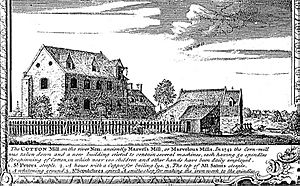Marvel's Mill facts for kids

Marvel's Mill was a very important factory in Northampton, England. It was also known as Marvell's Mill. This mill was built in 1742 by Edward Cave. It was special because it was the second factory in the world to spin cotton. It was also the first cotton factory to use a water wheel for power. This meant it didn't need people or animals to make the machines work! The mill used new roller spinning machines. These were invented by Lewis Paul and John Wyatt. Their first mill was in Birmingham in 1741.
Contents
History of Marvel's Mill
Marvel's Mill was not always a cotton factory. For a long time, it was a water-powered gristmill. A gristmill grinds grain into flour. Records show it existed as "Merewyns mill" as early as 1253.
From Monastery to Cotton Factory
The mill first belonged to the Priory of St Andrew in Northampton. After the dissolution of the monasteries (when the king took control of church lands), the town of Northampton owned it. They then rented it out to different people over the years.
In 1742, Edward Cave bought the mill. Cave was famous for publishing The Gentleman's Magazine. He became interested in the new roller-spinning machines invented by Lewis Paul and John Wyatt. A writer named Samuel Johnson helped connect them.
Cave bought a special permit to use five of Paul's machines. These machines had a total of 250 spindles. He paid £3 for each spindle. Cave chose Marvel's Mill after looking at other mills.
Building the New Mill
After buying the mill, Edward Cave tore down the old gristmill. He then built a new building just for the spinning machines. He also added other buildings. These included places to boil lye for bleaching cotton. There was also a workshop for a blacksmith to fix the machine parts.
Running the Mill
We don't know a lot about how the mill was run every day. But some old papers tell us a few things. Thomas Yeoman, a millwright, was in charge of the whole factory. A manager, Mr. Harrison, handled the daily tasks. A foreman, Mr. Newton, had worked at the earlier Birmingham mill.
Running the mill was not easy. In April 1743, they hoped to make £599 profit a year. They planned to have twelve machines. But by October of that year, only 50 of the planned 100 workers were there. The expected profit dropped to just £113.
John Wyatt wrote about the problems. He said, "The Cards and Carding, extremely ill maniged" (meaning the cotton preparing was bad). He also noted, "The Dirt and Cotton spread ab' the Rooms and the Pathways near the Mill is surprising." He thought the person in charge was "a very indifferent Maniger."
Later Years and Closure
Even with these problems, the business kept going. An engraving from 1746 shows the mill working. It had all 100 staff members.
When Edward Cave died in 1754, his brother and nephew took over the mill. At this time, Samuel Touchet became involved. He was a major cotton merchant from Lancashire. Touchet had also been allowed to use Paul's machines since 1742. He had even set up a second mill in Birmingham.
However, Touchet didn't make any money from Marvel's Mill. In 1756, the mill and its machines were put up for sale. Eventually, Lewis Paul rented it again and took direct control. But after Paul died in 1759, the Caves took the mill back in 1761 because he hadn't paid rent.
There is no sign that cotton spinning happened at the mill after this date. By 1768, the mill was owned by "William Faulkner and Thomas Harris, millers." By 1774, a shoemaker was using the yard.
We don't know what happened to the spinning machines. But there are hints that Richard Arkwright might have seen them. His famous 1769 patent for a spinning machine was based on very similar ideas.
Images for kids
-
"The Cotton Mill on the River Nen", from Noble and Butlin's 1746 map of Northampton - the earliest known pictorial representation of a cotton mill.
See also
 In Spanish: Marvel's Mill para niños
In Spanish: Marvel's Mill para niños


